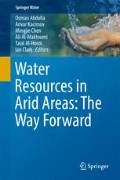Abstract
The integrated management of transboundary waters has increasingly becoming a heavy burden facing decision-makers and water managers, especially in downstream countries. Human-intervention activities upstream combined with prolonged droughts have intensified the challenges encounter the water governance in a sustainable manner. This study quantifies the combined effects of upstream man-made modifications and basin-wide extended droughts on temporal river flow paradigms of the downstream riparian country. The Diyala watershed of about 32,000 km2 shared between Iraq and Iran was chosen as an example case study. The Indicators of the Hydrologic Alteration (IHA) and the Range of Variability Approach (RVA) were adopted to characterise the streamflow alteration. Findings reveal that the joint impact has destructively influenced the development of the middle and lower portions of the basin in the downstream country, including the security of the irrigated agriculture, domestic and industrial water demands, and prompted people to leave their homes and lands coupled with growing conflicts between tribes. Prolonged severe droughts were marked between 1999 and 2015. The size and magnitude of the joint impact are anticipated to increase in the foreseeable future when under construction and future planned water withdrawal facilities upstream will be commissioned. The two successive acute droughts of (1999–2001) and (2008–2009) twinned with upstream regulation practices have hindered the socio-economic activities and deteriorated the environmental system of the middle and lower portions of the Diyala basin in the lower country.
Access this chapter
Tax calculation will be finalised at checkout
Purchases are for personal use only
References
Al-Faraj FAM, Al-Dabbagh BNS (2015) Assessment of collective impact of upstream watershed development and basin-wide successive droughts on downstream flow regime: the Lesser Zab transboundary basin. J Hydrol 530(2015):419–430. doi:10.1016/j.jhydrol.2015.09.074
Al-Faraj FAM, Scholz M (2014) Assessment of temporal hydrologic anomalies coupled with drought impact for a transboundary river flow regime: the Diyala watershed case study. J Hydrol 517:64–73
Al-Faraj FAM, Scholz M (2015) Impact of upstream anthropogenic river regulation on downstream water availability in transboundary river watersheds. Int J Water Res Dev 31(1):28–49. doi:10.1080/07900627.2014.924395
Al-Faraj FAM, Tigkas D, Scholz M (2015) Sensitivity of irrigation requirements to improvement in irrigation system performance efficiency. Example of transboundary watershed. In: The 9th World Congress of the European Water Resources Association (EWRA), Istanbul, Turkey between 10 and 13 June 2015
Intergovernmental Panel on Climate Change. Climate Change (2014) Impacts, adaptation, and vulnerability. Available online: http://www.ipcc.ch/report/ar5/wg2. Accessed 25 Oct 2015
Harza Engineering Company and Binnie & Partners (1959) Hydrological survey of Iraq; discharges for selected gauging stations in Iraq, Report. Harza Engineering Company, Chicago, IL; Binnie & Partners, London
Harza Engineering Company and Binnie & Partners (1963) Hydrological survey of Iraq; main report. Harza Engineering Company, Chicago, IL; Binnie & Partners, London
Harza Engineering Company and Binnie & Partners (2014) Hydrological survey of Iraq; discharges for selected gauging stations in Iraq, report. Harza Engineering Company, Chicago, IL; Binnie & Partners, London, Water 2014, 6 3048
Ministry of Agriculture and Water Resources-Kurdistan Regional Government (MA and WR-KRG) (2013) Various official data sets, general directorate of dams and reservoirs and directorate for operation of Derbandikhan; MA and WR-KRG: Erbil and Sulaymaniyah, Iraq
Richter BD, Baumgartner JV, Powel J, Braun D (1996) A method for assessing hydrologic alteration within ecosystems. Conserv Biol 10:1163–1174
Richter BD, Baumgartner JV, Wigington R, Braun DP (1997) How much water does a river need? Freshw Biol 37(1):231–249
Richter BD, Baumgartner JV, Powel J, Braun D (1998) A spatial assessment of hydrologic alteration within a river network. Regul Rivers Res Manage 14:329–340
Shiau JT, Wu FC (2004a) Assessment of hydrologic alterations caused by chi-chi diversion Weir in Chou-Shui Creek, Taiwan: opportunities for restoring natural flow conditions. River Res Appl 20(4):401–412
Shiau JT, Wu FC (2004b) Feasible diversion and instream flow release using range of variability approach. J Water Resour Plan Manage 130(5):395–404
USGS (2010) Stream gage descriptions and streamflow statistics for sites in the Tigris River and Euphrates River Basins, Iraq. A technical report prepared in cooperation with MoWR and MoAg&WR-KRG under the auspices of the U.S. Department of Defence, Task Force for Business and Stability Operations
Zuo Q, Liang S (2015) Effects of dams on river flow regime based on IHA/RVA. Remote sensing and GIS for hydrology and water resources (IAHS Publ. 368, 2015). In: Proceedings RSHS14 and ICGRHWE14, Guangzhou, China, August 2014. doi:10.5194/piahs-368-275-2015. Available online http://www.proc-iahs.net/368/275/2015/piahs-368-275-2015.pdf. Accessed 30 Nov 2015
Acknowledgements
The author would like to express his great appreciation to the Ministry of Agriculture and Water Resources in Iraqi Kurdistan, General Directorate of Dams and Reservoirs and Derbandikhan Dam Commission for their full support in data provision.
Author information
Authors and Affiliations
Corresponding author
Editor information
Editors and Affiliations
Rights and permissions
Copyright information
© 2017 Springer International Publishing AG
About this paper
Cite this paper
Al-Faraj, F.A.M. (2017). Collective Impact of Upstream Anthropogenic Interventions and Prolonged Droughts on Downstream Basin’s Development in Arid and Semi-arid Areas: The Diyala Transboundary Basin. In: Abdalla, O., Kacimov, A., Chen, M., Al-Maktoumi, A., Al-Hosni, T., Clark, I. (eds) Water Resources in Arid Areas: The Way Forward. Springer Water. Springer, Cham. https://doi.org/10.1007/978-3-319-51856-5_2
Download citation
DOI: https://doi.org/10.1007/978-3-319-51856-5_2
Published:
Publisher Name: Springer, Cham
Print ISBN: 978-3-319-51855-8
Online ISBN: 978-3-319-51856-5
eBook Packages: Earth and Environmental ScienceEarth and Environmental Science (R0)

